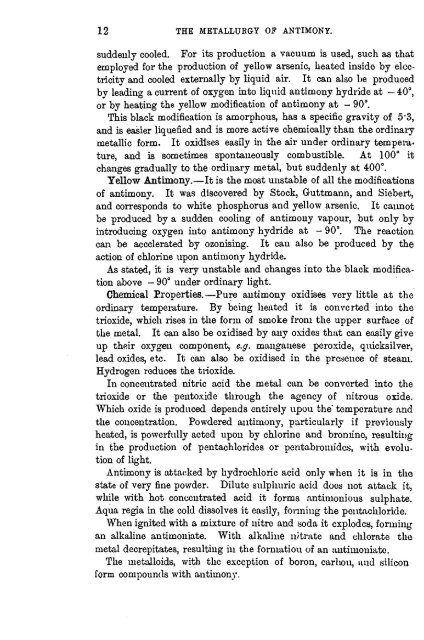antimony - Sciencemadness.org
antimony - Sciencemadness.org
antimony - Sciencemadness.org
You also want an ePaper? Increase the reach of your titles
YUMPU automatically turns print PDFs into web optimized ePapers that Google loves.
12 THE METALLURGY OF ANTIMONY.<br />
suddenly cooled. For its production a vacuum is used, such as that<br />
employed for the production of yellow arsenic, heated inside by electricity<br />
and cooled externally by liquid air. It can also be produced<br />
by leading a current of oxygen into liquid <strong>antimony</strong> hydride at — 40°,<br />
or by heating the yellow modification of <strong>antimony</strong> at - 90°.<br />
This black modification is amorphous, has a specific gravity of 5*3,<br />
and is easier liquefied and is more active chemically than the ordinary<br />
metallic form. It oxidises easily in the air under ordinary temperature,<br />
and is sometimes spontaneously combustible. At 100° it<br />
changes gradually to the ordinary metal, but suddenly at 400°.<br />
Yellow Antimony.—It is the most unstable of all the modifications<br />
of <strong>antimony</strong>. It was discovered by Stock, Guttmann, and Siebert,<br />
and corresponds to white phosphorus and yellow arsenic. It cannot<br />
be produced by a sudden cooling of <strong>antimony</strong> vapour, but only by<br />
introducing oxygen into <strong>antimony</strong> hydride at - 90°. The reaction<br />
can be accelerated by ozonising. It can also be produced by the<br />
action of chlorine upon <strong>antimony</strong> hydride.<br />
As stated, it is very unstable and changes into the black modification<br />
above - 90° under ordinary light.<br />
Chemical Properties.—Pure <strong>antimony</strong> oxidises very little at the<br />
ordinary temperature. By being heated it is converted into the<br />
trioxide, which rises in the form of smoke from the upper surface of<br />
the metal. It can also be oxidised by any oxides that can easily give<br />
up their oxygen component, e.g. manganese peroxide, quicksilver,<br />
lead oxides, etc. It can also be oxidised in the presence of steam.<br />
Hydrogen reduces the trioxide.<br />
In concentrated nitric acid the metal can be converted into the<br />
trioxide or the pent oxide through the agency of nitrous oxide.<br />
Which oxide is produced depends entirely upon the' temperature and<br />
the concentration. Powdered <strong>antimony</strong>, particularly if previously<br />
heated, is powerfully acted upon by chlorine and bromine, resulting<br />
in the production of pentachlorides or pentabromidos, with evolution<br />
of light.<br />
Antimony is attacked by hydrochloric acid only when it is in the<br />
state of very fine powder. Dilate sulphuric acid does not attack it,<br />
while with hot concentrated acid it forms antimonious sulphate.<br />
Aqua regia in the cold dissolves it easily, forming the pentachloride.<br />
When ignited with a mixture of nitre and soda it explodes, forming<br />
an alkaline antimoniate. With alkaline nitrate and chlorate the<br />
metal decrepitates, resulting in the formation of an antimoniato.<br />
The metalloids, with the exception of boron, carbon, and silicon<br />
form compounds with <strong>antimony</strong>.
















